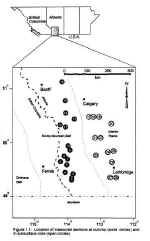|
1995. Ph.D., 343 pp.
PALEOSOLS
OF THE CRETACEOUS BLAIRMORE GROUP IN S. ALBERTA
McCarthy,
P.
 Good
exposures of the paleosol-bearing Lower Cretaceous (Albian) upper Blairmore
Group are present in the vicinity of Crowsnest Pass, southwestern Alberta. The
Beaver Mines and Mill Creek formations, and Crowsnest Volcanics, comprise the
upper part of a thick, predominantly non-marine clastic wedge, shed from the
rising Cordillera to the west during Albian time. These units interfinger to the
east and northeast with the subsurface Bow Island (Viking equivalent) Formation. Good
exposures of the paleosol-bearing Lower Cretaceous (Albian) upper Blairmore
Group are present in the vicinity of Crowsnest Pass, southwestern Alberta. The
Beaver Mines and Mill Creek formations, and Crowsnest Volcanics, comprise the
upper part of a thick, predominantly non-marine clastic wedge, shed from the
rising Cordillera to the west during Albian time. These units interfinger to the
east and northeast with the subsurface Bow Island (Viking equivalent) Formation.
The Beaver Mines Formation consists
of interbedded channel sandstones and thick overbank mudstones and sandstones,
interpreted as high sinuosity fluvial channel sands and floodplain. In the
south, the Beaver Mines Formation is overlain by up to 35 m of upward coarsening
shales and sartdstones interpreted as prograding offshore to shoreface deposits.
An angular unconformity separates the marine succession from a 10-15 m thick,
quartz and chert-rich pebbly, regionally extensive, multistory, low sinuosity
fluvial sandstone. This is overlain by high sinuosity fluvial sandstones and
mudstones of the Mill Creek Formation.
Evidence of pedogenesis is
ubiquitous. Individual soil profiles (sensu stricto) are rare, however
thick, polygenetic, cumulic pedogenic successions are common. These pedogenized
successions contain abundant evidence of soil development including: root
traces, colour mottles, blocky structure, slickensides, clay void coatings, iron
coatings, in situ organic matter, iron and calcite nodules, and strial
fabrics.
Despite the weak development of
paleosol profiles, the paleosol successions indicate that variable rates of
sedimentation and pedogenesis occurred on the floodplains. Abundant
paleoenvironmental information is obtained from the presence of individual
features, the paragenesis of compound features, and, especially, from
assemblages of features. The paleosol successions contain assemblages of
features similar to recent Alfisols, gleyed Alfisols, and vertic Alfisols
suggesting development in a warm, temperate climate, subjected to alternating
wet and dry conditions. Thermodynamic models suggest that these pedogenic
features could have survived subsequent burial and uplift.
At least two levels of smaller scale pedo-sedimentary
cyclicity are identified, which provide details of the local floodplain response
to upstream controls (tectonics, sediment supply) and basinal controls
(subsidence, eustasy). Small-scale cycles (20-50 cm thick) occur within
individual colour units. They are related to depositional events in which
synsedimentary cumulative pedogenesis occurred. Large-scale cycles (1-3 m),
identified by both grain size and colour changes, reflect major changes in
floodplain stability and hydrological conditions at a site.
|